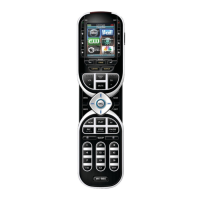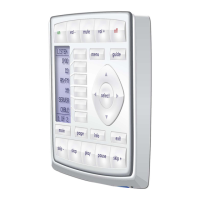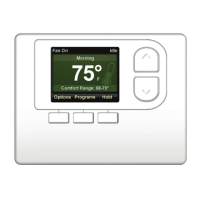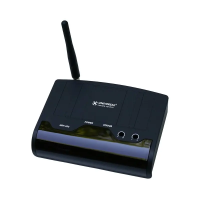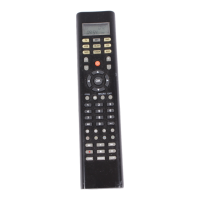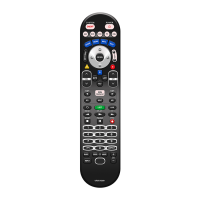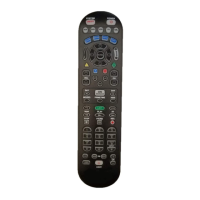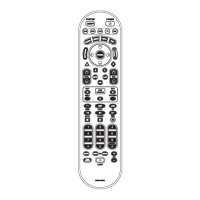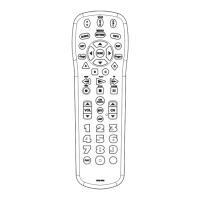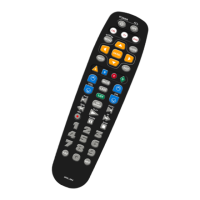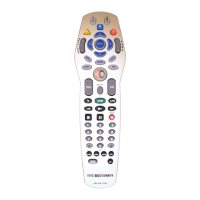Do you have a question about the Universal Remote Control Complete Control MX-980 and is the answer not in the manual?
| Type | Universal Remote Control |
|---|---|
| Brand | Universal Remote Control |
| Model | Complete Control MX-980 |
| Display | LCD |
| Display Size | 2.4 inches |
| Backlight | Yes |
| IR Range | Up to 30 feet |
| Backlit Buttons | Yes |
| Macro Commands | Yes |
| Connectivity | RF, IR |
| Control Method | Buttons, Touchscreen |
| Battery Type | Lithium Ion |
| Compatible Devices | TVs, Audio Receivers, Blu-ray Players, etc. |
Overview of CCP for MX-980 and its interface.
Explanation of the CCP interface's main menu and toolbar.
Tree views for system configuration in CCP.
Interface for simulating remote control actions.
Window for viewing and editing button properties and tools.
Area for creating and editing macros.
Highlights new functionalities and improvements in CCP.
Setting up rooms and devices within House Designer.
Managing rooms, base stations, and remotes.
Steps to install CCP on Windows and set up ActiveSync.
Necessary computer hardware and OS for CCP installation.
Steps to install CCP and its companion software.
Guide for setting up the ActiveSync program.
Window for establishing connection with mobile devices.
Using Live Update for software and IR database updates.
Overview of CCP's interface elements like menu and windows.
Resizing, moving, and grouping CCP windows.
Description and restoration of the standard CCP window arrangement.
Using float, dock, auto-hide, and hide functionalities for windows.
Following the Program Menu sequence for best results.
Archiving and importing customized device files.
Managing CCP files: creating, opening, uploading.
Detailed guide for creating a new system file.
Adding base stations into rooms in House Designer.
Configuring properties for base stations.
Setting RF ID, Name, and Port Information.
Saving the system configuration using "Save As".
Using Control+Z for undo functionality.
Speeding up macro programming with function view.
Window for creating and naming devices.
Tool for creating and editing button layouts.
MX-980's color capabilities and architecture.
Artwork placement for LCD buttons.
Using pre-built templates for programming.
Overview of the editor's main interface.
The simulator and page view interface.
Dockable windows for editing.
Creating, opening, and uploading CCP configuration files.
Using "Save As" to rename configuration files.
Navigating the CCP programming workflow.
Modifying layouts using page view and shortcuts.
Importing and reusing customer configuration files.
Interface for creating and naming devices.
Choosing icon styles for devices.
Requirement to create devices before adding pages.
Tool for creating and editing button layouts.
Choosing the correct button layout for a device.
Adding new pages or updating existing ones.
Assigning IR command sets to devices.
Selecting the brand and model of a component.
Choosing devices and component categories for IR data.
Selecting exact models or inclusive code sets.
Verifying IR commands using the test function.
Progressing through devices using NEXT DEVICE.
Testing IR commands on the remote.
Understanding the difference between discrete and toggle commands.
Locating discrete commands with the navigator.
Selecting IR data, brand, and model for commands.
Moving IR commands to simulator buttons.
Importing learned IR codes via the Universal Browser.
Using Tree View and Panel View in the browser.
Using Tree View to find commands.
Understanding Trigger, Learned, Pre-Programmed, Macro flags.
Rearranging buttons using keyboard modifiers.
Downloading, testing, and arranging buttons.
Controlling open pages using the Window menu.
Rearranging button labels and actions without swapping artwork.
Typing text into the Normal Text window for labels.
Continuing tests and editing pages as needed.
Making pages inaccessible to the end-user.
Techniques for learning codes from tricky devices.
Method for learning individual IR codes.
Choosing buttons on the simulator for IR learning.
Activating the learning process via the Program menu.
Verifying learned IR commands.
Using the DoubleTap method for specific protocols.
Clicking SAVE to store learned IR commands.
Efficiently learning multiple buttons.
Monitoring the learning process status.
Skipping buttons or testing codes.
Downloading codes and testing their functionality.
Modifying repeat settings for IR commands.
Adjusting repeat settings for sustained IR output.
Verifying IR codes after adjusting repeats.
Creating reliable macros versus those prone to failure.
Strategies for missing discrete codes.
Strategies for managing TV inputs.
Controlling macro recording and editing.
Record, Stop, Delete steps for macro editing.
If/Else, Toggle, Delay, Jump To, Text steps.
Creating macros for powering on systems.
Sequencing power on for multiple components.
Configuring inputs for favorite activities.
Creating jump steps to specific pages.
Adding and configuring delay steps in macros.
Verifying macro functionality with delays.
Creating macros for powering off devices.
Reusing programmed macros.
Accessing the macro editing window.
Explanation of buttons in the macro toolbar.
Overview of Normal, Press Time, and Variable modes.
Configuring macro modes for buttons.
Using press time for conditional macros.
Utilizing variables for conditional macros.
Using variables for timed device operations.
Defining and using aliases for macro steps.
Steps to record macros.
Removing steps from a macro.
Speeding up macro programming with function view.
Configuring default button sounds.
Importing and using sound files.
Using images instead of text for buttons.
Replacing button art by dragging images.
Accessing and viewing image galleries.
Using normal and pressed image states.
Optimizing the device window for performance.
Setting functions to punch through to other devices.
Modifying RF properties for MX-6000.
Configuring receiver and port settings.
Importing learned IR and database codes.
Using Tree View and Panel View in the browser.
Entering and using Pronto Hex Codes.
Steps for transferring configuration to the MX-980.
Accessing and configuring MX-980 settings.
